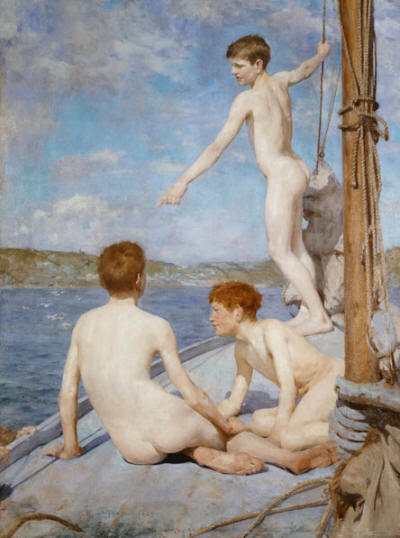

Partner Charles Kains Jackson
Queer Places:
St Joseph's Church, 67 Purewell, Christchurch BH23 1EH, UK
Usher Art Gallery, 1 Danes Terrace, Lincoln LN2 1LP, UK
 Cecil Egbert Jackson Castle (April 25, 1870 - June, 1922). Charles
Kains Jackson published two small books of poetry, both concerning his romance with his cousin Cecil Castle.
If we need a precise date for the beginnings of beefcake art, it would be 1888. In that year Henry Scott Tuke's
finest and most deservedly famous painting The Bathers was exhibited in the
New English Art Club. The exhibition prompted a lovely poem on Hyacinthus by
Charles Kains Jackson in the Artist and Journal of Home Culture, a magazine
edited by Jackson. The Artist had a popularity somewhat similar to the
American Saturday Evening Post (the vehicle for Rockwell's illustrations),
except that while it was disseminating "home culture" it was also a major
vehicle for the propagation of carefully veiled homosexual verse and short
fiction — and eventually for discreet studies of the male nude. Jackson was a
friend of Tuke, and often visited him, and there is good reason to believe
that one of the figures in The Bathers is Jackson's fourteen-year-old
boyfriend Cecil Castle (the other figures are Willy Rowling and Albert
Pidwell; the painting is in the Usher Art Gallery, Lincoln).
Cecil Egbert Jackson Castle (April 25, 1870 - June, 1922). Charles
Kains Jackson published two small books of poetry, both concerning his romance with his cousin Cecil Castle.
If we need a precise date for the beginnings of beefcake art, it would be 1888. In that year Henry Scott Tuke's
finest and most deservedly famous painting The Bathers was exhibited in the
New English Art Club. The exhibition prompted a lovely poem on Hyacinthus by
Charles Kains Jackson in the Artist and Journal of Home Culture, a magazine
edited by Jackson. The Artist had a popularity somewhat similar to the
American Saturday Evening Post (the vehicle for Rockwell's illustrations),
except that while it was disseminating "home culture" it was also a major
vehicle for the propagation of carefully veiled homosexual verse and short
fiction — and eventually for discreet studies of the male nude. Jackson was a
friend of Tuke, and often visited him, and there is good reason to believe
that one of the figures in The Bathers is Jackson's fourteen-year-old
boyfriend Cecil Castle (the other figures are Willy Rowling and Albert
Pidwell; the painting is in the Usher Art Gallery, Lincoln).
Cecil Egbert Jackson Castle was born in Banda, Bengal, India on 25 Apr 1870 to Captain Charles Thomas Castle and Annie Maria Castle. He married Josephine Mary Kirkpatrick.
Jackson lived with Cecil in Tyneham House, London, in the infamous company of Frederick Rolfe, self-styled "Baron Corvo." Corvo was not at all averse to the delights of the male nude in art (and life), and he took a photograph of Cecil Castle, nude, lying on his stomach, which was printed in the Studio, another mainstream art journal with a gay subtext edited by the bisexual Joseph Gleeson White — also a friend of Tuke. It was at White's home that Corvo met Tuke, and Tuke had given him some drawings of boys to stimulate Corvo's artistic interests. Corvo wrote to Tuke's most intimate friend, Charles Masson Fox, that Tuke's talents would be best served if he went to Venice: One thing this world wants is some Tuke pictures of the Venetian lagoon and some Tuke pictures of mediaeval gondoglieri poised on poppe in Venetian Canals. But "Tuke has all he wants at Falmouth." Hum! Arnold of Rugby held that no man ought to be a school-master longer than 15 years at a stretch!
Corvo had extracted all he needed from his many gay adventures in Italy, and when he was hired to create the fresco for the church of St Joseph's in Christchurch, he had on hand a good supply of nude photographs of his Italian boyfriends. He would project these upon the wet plaster (with a "magic lantern") in order to draw the outlines for his religious figures. Jackson recalls watching in wonderment as Corvo projected upon the wall a photo of a nude boy "of seventeen years, yellow haired and blue eyed and of the most exquisite physical development ... instantaneously photographed in mid- air, when leaping into the Lake of Nemi." This became the mural "Ascension of Christ." Among the Nine Orders of Corvo's Celestial Hierarchy in this very fine fresco can be discerned the Archangel Michael, created by projecting upon the wall the nude photograph of Cecil on his stomach, upon the print of which Corvo had carefully drawn a spear, a shield, and a pair of wings.
Cecil Castle passed away on Jun 1922 in Richmond, Surrey, England.
My published books: